I’ve meant to write about funnel building for a while now. There’s so much to say! You could say the eCommerce funnel bug bit me in 2020, so in the following lines, I will not only explain everything there is to know about funnels but why they are worth knowing. But first things first.
How did I get hooked on the funnel hype?
Russell Brunson is one of the most exciting marketers around. I follow him rigorously, so I’m up to date with all of his projects. His company, ClickFunnels, is growing SO fast. They now make more than $100M in annual sales and have way over 100k paying customers and counting!
As the affiliate marketing genius he is, he has sold hundreds of thousands of books where he teaches his secrets. He is the person responsible for popularizing the concept of sales funnels through his company.
ClickFunnels is a software company that allows you to build a high-quality landing page and funnels to sell a product or capture customer information.
Most importantly, Clickfunnels takes customers through a multistep process, which increases your Customer Lifetime Value CLTV and Average Order Value AOV and eventually allows companies or individuals to increase profit significantly.
What the heck is a funnel?
A funnel represents the series of steps a user takes from becoming aware of a product or service to “converting,” becoming a paid customer, and eventually, a loyal customer and advocate.
The funnel analogy works well because you may experience leaks (meaning, loss of customers) throughout all stages of your funnel. The goal of conversion rate optimization is to fix the holes in the funnel by increasing user engagement.
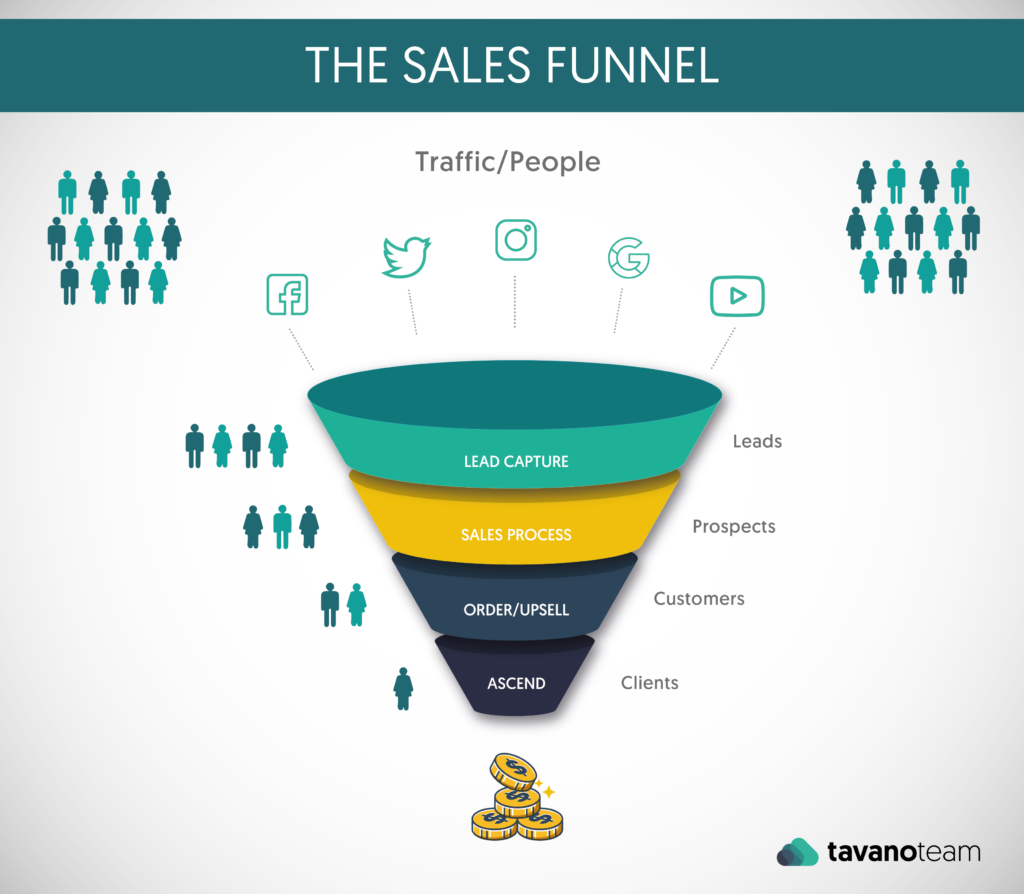
Funnels guide users through these pages that aim to sell your products and services, also adding upselling options to your sales process.
Some eCommerce businesses are more profitable than others because they understand that the difference between a $10K website and a $10M website happens AFTER a buyer comes through the initial funnel.
Funnel-building: What’s the difference between funnel and website?
Generally speaking, traffic arrives at a website and travels to different areas, whether it’s a product page, About Us, or a blog post. From there, navigation can take them anywhere, and they could get lost or lose focus because a website has a lot of noise and distractions.
However, a funnel is engineered so that traffic flows linearly from one point of entry through a sequence of specific planned actions that lead to a particular goal.
For example, most websites cater towards a few user personas and a few strategic goals. At the same time, a typical funnel would focus on a specific user persona instead of a customer avatar and a particular purpose of conversion. You must understand your customers before building out your funnel.
A website is usually a two-dimensional business, and a funnel is a three-dimensional experience.
Funnel pages do not have headers or footers, nor different options on where to click. Funnels don’t have any distractions and have just one goal, and that is to sell you a product or service with its upsells, cross-sells, and down-sells as much as they can, focusing on two main metrics, CLTV and AOV.
Ultimately the customer can move forward and deeper into the funnel or abandon the site, which you can prevent with a few techniques.
What does it mean?
It means that a website allows you to publish products and content that helps you generate organic traffic through ranking on search engines.
Funnels convert paid traffic and focus on increasing the AOV and LTV of those customers.
A traditional website works similarly to having a salesperson. It presents complete information in hopes of making a sale. On the other hand, a sales funnel is like taking your very best salesperson, cloning them, and making it so they:
- Grab every single one that comes to the website
- Introduce themselves and build rapport
- Find out what they are interested in and
- Take them to buy the actual product or service
The funnel cycle should never end unless the user decides to. Good funnels provide value in each step, making it hard for customers to ignore or abandon.
Websites and funnels can coexist. Many successful modern-day websites contain multiple funnels. For example, you can use your blog or pages to drive traffic to different funnels specific to your user’s topics of interest.
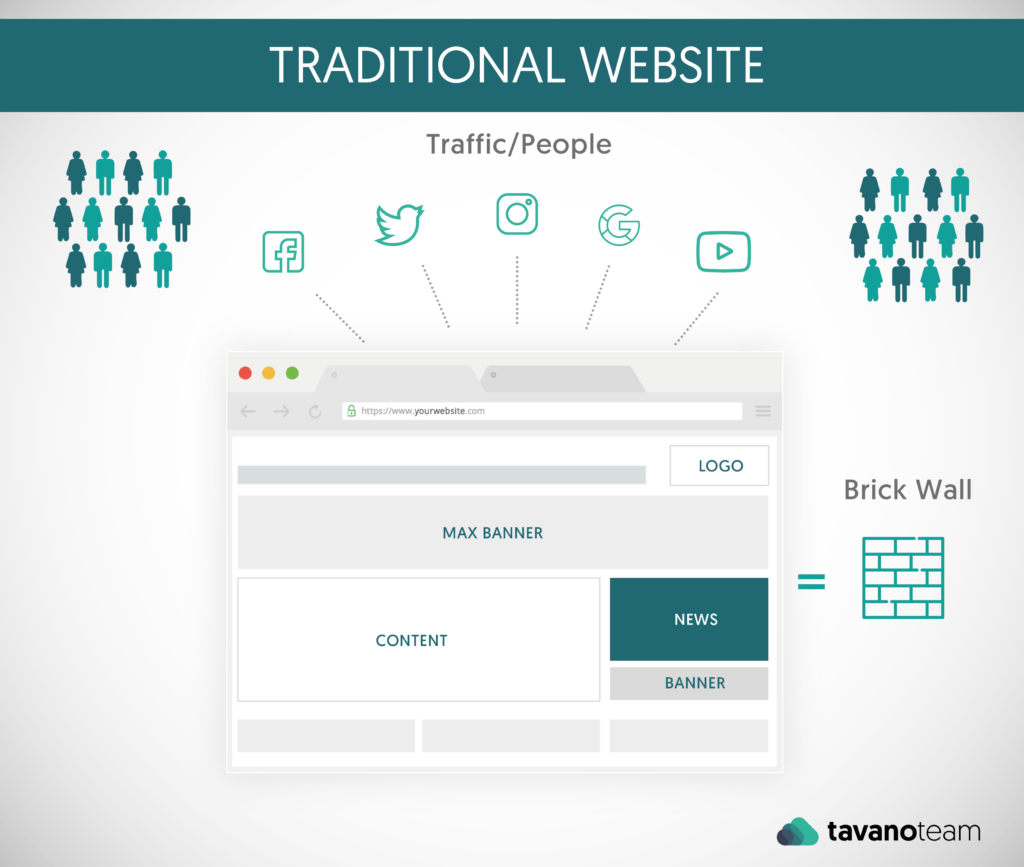
What does a funnel look like?
There are many funnels: for generating leads, funnels to sell products, or even event funnels. There are also subcategories within these.
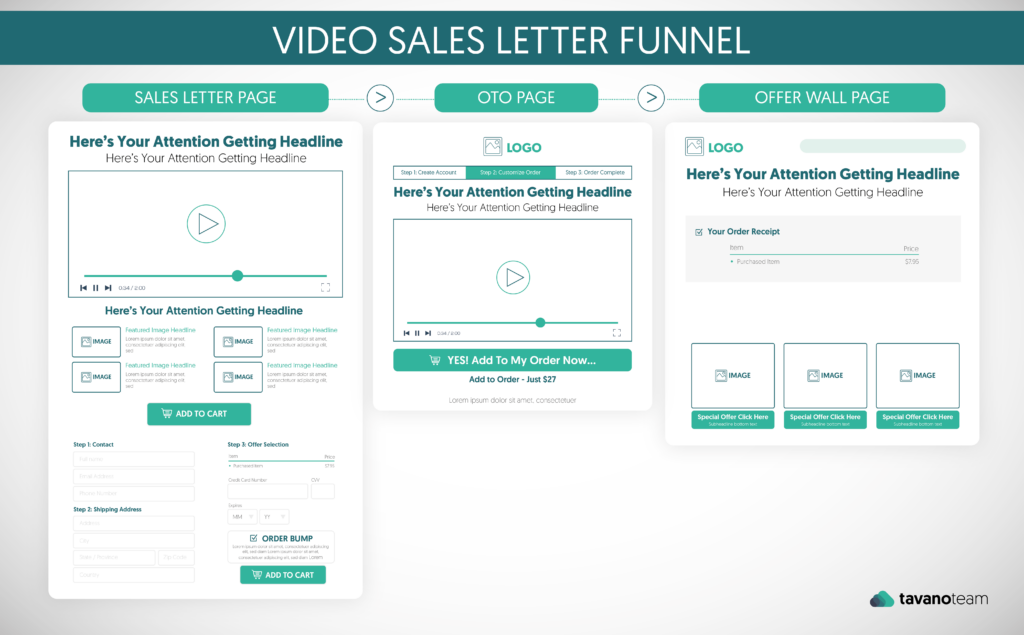

For example, within proved funnels to sell products, we can find the Tripwire funnel. This funnel consists of just three pages:
1 . The first page is a two steps sales page for a lower ticket product.
This page displays a video and text to explain the product, with a highly visible order form. It’s a 2-step order form.
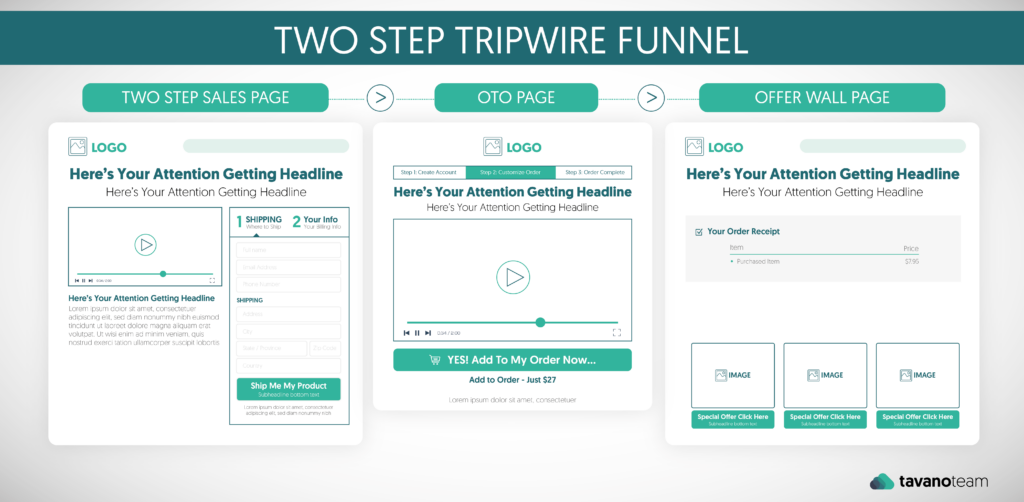
First, you ask for the shipping information, then the credit card information. If the user abandons the site at this point before confirming the credit card information, you still have their email address, and you can reach out to that person later.
You need to put together such an irresistible offer (which could be free, even), something SO good that your particular audience can’t refuse. It’s common to add a “One-click upsell” checkbox at the credit card step.
2 . The second page is a One-Time-Offer page.
It’s a special offer presented on that page only, so it generates scarcity.
Even though you already charged the previous low ticket item, the order doesn’t appear as completed until the users decide if they take on this One-Time-Offer or not.
There’s no risk of checkout abandonment if they refuse it because the shopper confirmed the initial offer. Regardless of the customer’s choice, they are directed to a special thank you page, which brings us to:
3 . The third and last page is nothing more than a Thank You page that will include new baits to encourage shoppers to get through your other funnels.
With these as a base, you can get creative and make the funnel work for your specific needs. You could even add a fourth page after the One Time Offer where, if rejected, you can offer a down-sell alternative.
Another subtype of product selling funnels is the sales letter or video funnel. Their structure is very similar to the previous examples, the main difference being the format you use to present your product and that your first funnel level needs to be a little more persuasive.
Last but not least is the Product Launch Funnel, which has five steps plus a pop-up. This funnel serves to sell expensive items or new products.
It’s important to remember that every funnel has the same objective: to hook you up while you climb their value ladder.
The Value Ladder
Traffic enters through it first, so your job is to convert as many shoppers as you can into customers by selling at the front, middle, and backend of your funnel.
A funnel needs to provide value to each customer at the unique level of service that he or she can afford. Funnels are not suitable for you if you are selling just one thing.
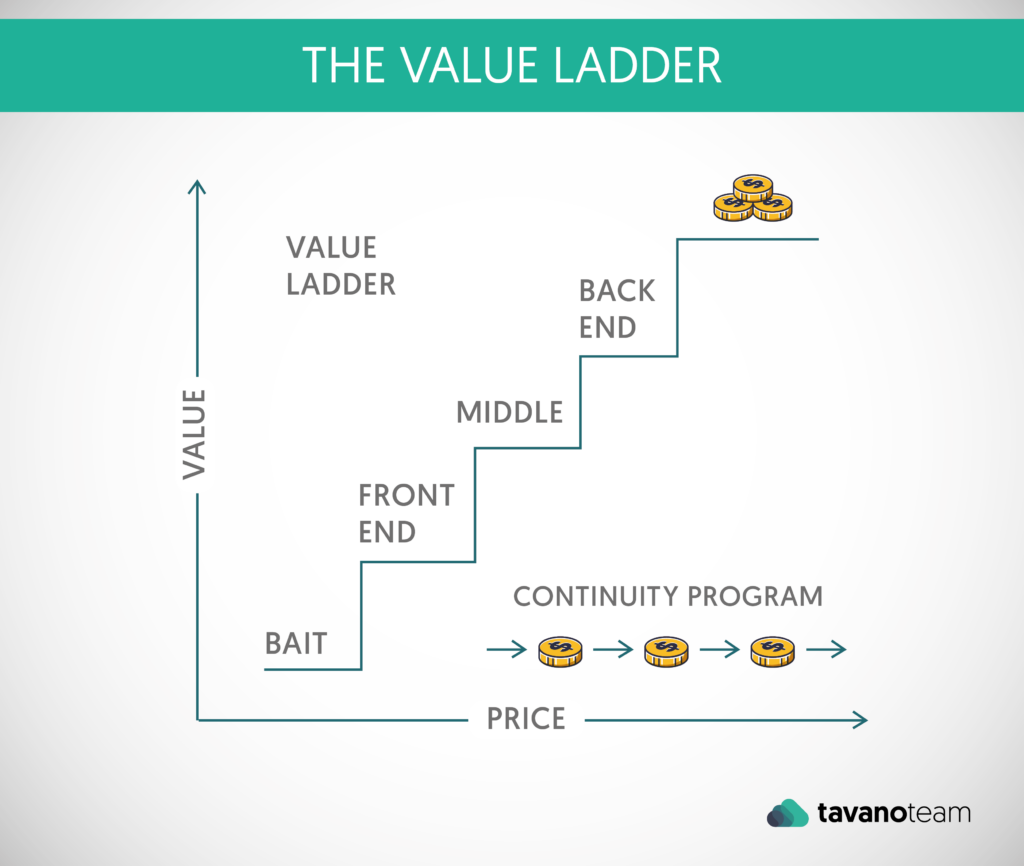
With a full Value Ladder, the traffic you acquire with your bait (ads) converts into customers with your irresistible low-ticket item at the front end. They then start ascending the value ladder, becoming more valuable to you as you keep increasing AOV and LTV at the same time.
The deeper the funnel is, the more things you can offer to your clients, and the more each customer is worth acquiring them.
Funnels, just as websites, are living and continuously changing and evolving creatures. You need to be on top of them.
The bottom line is the business that spends the most to acquire a customer wins.
When you have a funnel that works, you DON’T need an advertising budget. The more you invest, the more you get out of it.
But don’t be fooled! You have to maintain and optimize your funnel. If you think you can automate your work once your funnel is profitable, you crash.
Brunson insists you shouldn’t create funnels from scratch and that we should look for an effective funnel elsewhere and adapt it and model it to our needs.
He calls this “Funnel Hacking,” which consists of reverse engineering a successful funnel that relates closely to what you want to sell and mimic its structure, frequency, and step orders.
These are the five main elements to consider when funnel-building:
- Demographics: it’s vital to understand the characteristics, psychographics, and shared worldview of the people we target. Once we understand who they are, we know what offer to present.
- Offer: it’s what we are selling and at what price point, the upsells and down-sells. Always remember that the first offer you see is not the first offer; your primary offer is what you try to sell at the backend of your funnel.
- Landing page: this is the most critical page of your funnel. Funnel Hacking’s secret is not to try to reinvent the wheel. Find what’s working and mimic it. Afterward, you can tweak it and adapt it.
- Ad copy: What does it say? What structure does it have?
- Traffic source: Identify the origin of the traffic interested in your product. There are three types of traffic:
The traffic you own
…which is the best kind of traffic. It’s your email list, your subscribers, your followers. You don’t get it from bought databases nor from SEO or PR efforts, which is why it’s so essential to build the list of traffic you own.
The traffic you control.
This is the traffic you tell where to go but don’t own, like all paid traffic. You have it for a limited amount of time, so you control where you want them to go through a “Squeeze Page,” where your goal is to convert controlled traffic into owned traffic to exchange something of value to them.
The traffic you don’t control.
This traffic can come from social media, search traffic, interviews, Youtube; you name it. You do not control it at any point in the funnel; it just appears. Your goal is also to own this traffic, but learning how to convert traffic that you don’t control is the equivalent of finding the holy grail of online marketing.
To learn more about funnel building for your SuiteCommerce business and how you can benefit from it, contact us!
Also, make sure to follow us on Instagram, Facebook, and Twitter for the latest news and tips on SuiteCommerce.






